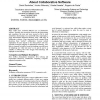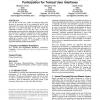GROUP
2005
ACM
14 years 5 months ago
2005
ACM
The Community Bar is groupware supporting informal awareness and casual interaction for small social worlds: a group of people with a common purpose. Its conceptual design is prim...
GROUP
2005
ACM
14 years 5 months ago
2005
ACM
This paper uses a long term ethnographic study of the design and implementation of an electronic patient records (EPR) system in a UK hospital Trust to consider issues arising in ...
GROUP
2005
ACM
14 years 5 months ago
2005
ACM
Publicly accessible bug report repositories maintained by free / open source development communities provide vast stores of data about distributed software problem management (SWP...
GROUP
2005
ACM
14 years 5 months ago
2005
ACM
Many studies have evaluated different uses of collaborative software. Typically, the research has focused on the shortcomings and, sometimes, the ways end users succeed or fail to...
GROUP
2005
ACM
14 years 5 months ago
2005
ACM
Shared workspace systems provide virtual places for selforganized and semi-structured cooperation between local and distributed team members. These cooperation systems have been a...
GROUP
2005
ACM
14 years 5 months ago
2005
ACM
Many virtual communities involve ongoing discussions, with large numbers of users and established, if implicit rules for participation. As new users enter communities like this, b...
GROUP
2005
ACM
14 years 5 months ago
2005
ACM
Recent proliferation of computing devices has brought attention to heterogeneous collaborative systems, where key challenges arise from the resource limitations and disparities. S...
GROUP
2005
ACM
14 years 5 months ago
2005
ACM
We introduce the use of negative preferences to produce solutions that are acceptable to a group of users. Using negative preference profiling, a system determines which solution...
GROUP
2005
ACM
14 years 5 months ago
2005
ACM
Over the last several years, studies of instant messaging have observed its increasing role in the workplace[1] and in social situations[2]. We propose that modifying applications...
GROUP
2005
ACM
14 years 5 months ago
2005
ACM
Although pair programming is becoming more prevalent in software development, and a number of reports have been written about it [4] [6], few have addressed the manner in which pa...


